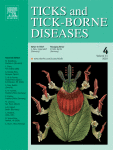Ver ítem
- xmlui.general.dspace_homeCentros Regionales y EEAsCentro Regional Santa FeEEA RafaelaArtículos científicosxmlui.ArtifactBrowser.ItemViewer.trail
- Inicio
- Centros Regionales y EEAs
- Centro Regional Santa Fe
- EEA Rafaela
- Artículos científicos
- Ver ítem
Clinical and epidemiological comparison of Rickettsia parkeri rickettsiosis, related to Amblyomma triste and Amblyomma tigrinum, in Argentina
Resumen
The aim of this work was to compare the epidemiological and clinical characteristics of Rickettsia parkeri rickettsiosis related to Amblyomma triste and Amblyomma tigrinum ecological regions in Argentina. We reviewed cases of R. parkeri rickettsiosis from 2007 to 2017 evaluated at Muñiz Hospital, directly or through referral. Univariate analysis was used to examine the association between different variables and the disease related by each vector species.
[ver mas...]
The aim of this work was to compare the epidemiological and clinical characteristics of Rickettsia parkeri rickettsiosis related to Amblyomma triste and Amblyomma tigrinum ecological regions in Argentina. We reviewed cases of R. parkeri rickettsiosis from 2007 to 2017 evaluated at Muñiz Hospital, directly or through referral. Univariate analysis was used to examine the association between different variables and the disease related by each vector species. The eighteen cases of R. parkeri rickettsiosis included had fever, inoculation eschar and all except one had rash. Regional differences in epidemiological variables were identified, depending on the vector. There was a significantly increased risk of exposure to A. tigrinum in peri-domestic areas (odd ratio 12, p = 0.02), whereas an increased risk of exposure to A. triste was evident in wildlife areas (odd ratio 12, p = 0.02). Seasonality of R. parkeri rickettsiosis differed based on its vector. Cases associated with A. triste occurred predominantly during spring and summer, whereas those associated with A. tigrinum occurred during fall, winter, and springtime. Exanthema was maculopapular (13/18), maculo-vesicular (3/18) or petechial (1/18). No clinical differences were identified depending on the vector.
[Cerrar]

Autor
Romer, Yamila;
Borras, Pablo;
Govedic, Francisco;
Nava, Santiago;
Carranza, José Ignacio;
Santini, María Soledad;
Armitano, Rita Inés;
Lloveras, Susana;
Fuente
Ticks and Tick-borne Diseases 11 (4) : 101436 (July 2020)
Fecha
2020-07
Editorial
Elsevier
ISSN
1877-959X
Formato
pdf
Tipo de documento
artículo
Palabras Claves
Derechos de acceso
Restringido
 Excepto donde se diga explicitamente, este item se publica bajo la siguiente descripción: Creative Commons Attribution-NonCommercial-ShareAlike 2.5 Unported (CC BY-NC-SA 2.5)
Excepto donde se diga explicitamente, este item se publica bajo la siguiente descripción: Creative Commons Attribution-NonCommercial-ShareAlike 2.5 Unported (CC BY-NC-SA 2.5)

